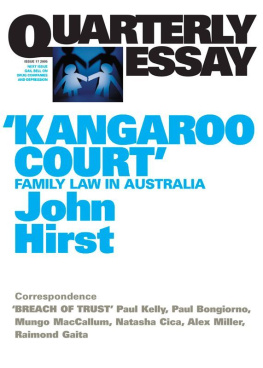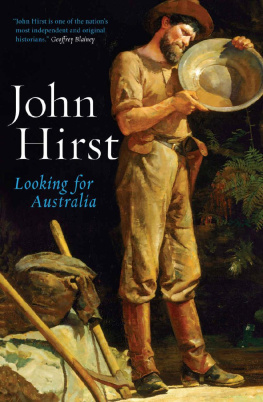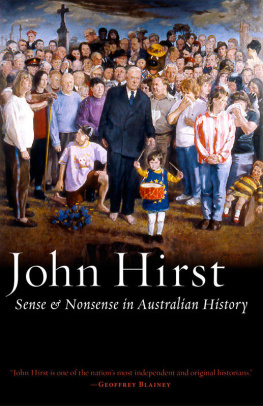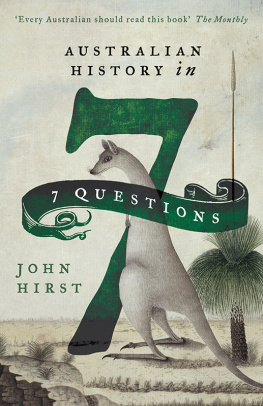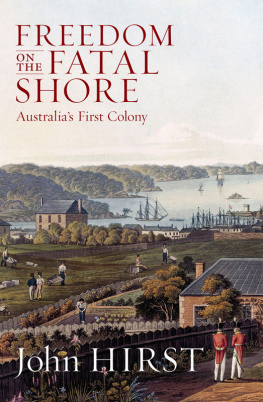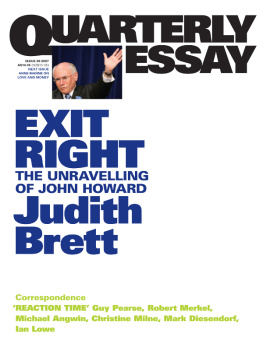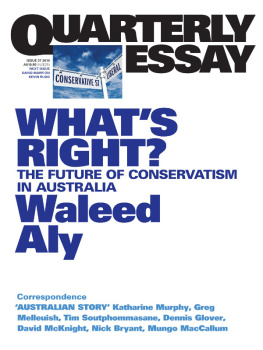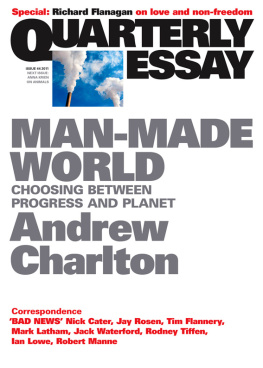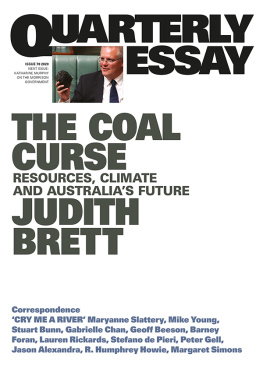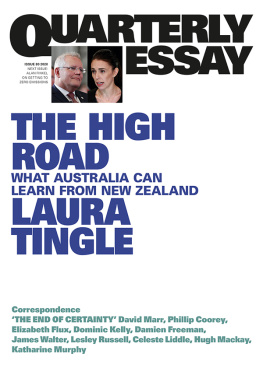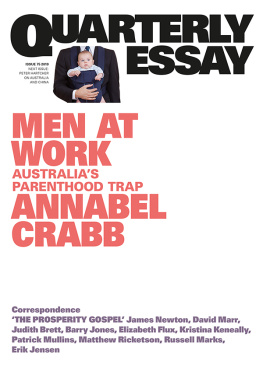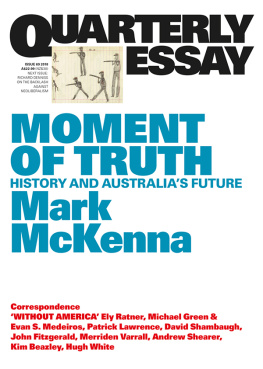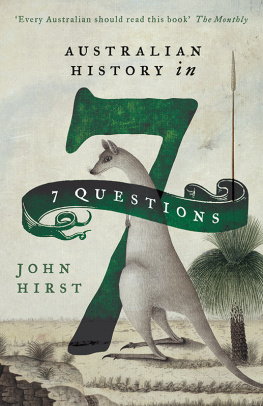John Hirst - Quarterly Essay 17 ’Kangaroo Court’: Family Law in Australia
Here you can read online John Hirst - Quarterly Essay 17 ’Kangaroo Court’: Family Law in Australia full text of the book (entire story) in english for free. Download pdf and epub, get meaning, cover and reviews about this ebook. year: 0, genre: History. Description of the work, (preface) as well as reviews are available. Best literature library LitArk.com created for fans of good reading and offers a wide selection of genres:
Romance novel
Science fiction
Adventure
Detective
Science
History
Home and family
Prose
Art
Politics
Computer
Non-fiction
Religion
Business
Children
Humor
Choose a favorite category and find really read worthwhile books. Enjoy immersion in the world of imagination, feel the emotions of the characters or learn something new for yourself, make an fascinating discovery.
- Book:Quarterly Essay 17 ’Kangaroo Court’: Family Law in Australia
- Author:
- Genre:
- Year:0
- Rating:5 / 5
- Favourites:Add to favourites
- Your mark:
- 100
- 1
- 2
- 3
- 4
- 5
Quarterly Essay 17 ’Kangaroo Court’: Family Law in Australia: summary, description and annotation
We offer to read an annotation, description, summary or preface (depends on what the author of the book "Quarterly Essay 17 ’Kangaroo Court’: Family Law in Australia" wrote himself). If you haven't found the necessary information about the book — write in the comments, we will try to find it.
Quarterly Essay 17 ’Kangaroo Court’: Family Law in Australia — read online for free the complete book (whole text) full work
Below is the text of the book, divided by pages. System saving the place of the last page read, allows you to conveniently read the book "Quarterly Essay 17 ’Kangaroo Court’: Family Law in Australia" online for free, without having to search again every time where you left off. Put a bookmark, and you can go to the page where you finished reading at any time.
Font size:
Interval:
Bookmark:
Quarterly Essay
Quarterly Essay is published four times a year by Black Inc., an imprint of Schwartz Publishing Pty Ltd
Publisher: Morry Schwartz
ISBN 186 395 3418
ISSN 1832-0953
Subscriptions (4 issues): $49 a year within Australia incl. GST (Institutional subs. $59). Outside Australia $79. Payment may be made by Mastercard,Visa or Bankcard, or by cheque made out to Schwartz Publishing. Payment includes postage and handling.
To subscribe, fill out and post the subscription form on the last page of this essay, or subscribe online at:
www.quarterlyessay.com
Correspondence and subscriptions should be addressed to the Editor at:
Black Inc.
Level 5, 289 Flinders Lane
Melbourne VIC 3000 Australia
Phone: 61 3 9654 2000
Fax: 61 3 9654 2290
Email: quarterlyessay@blackincbooks.com
http://www.quarterlyessay.com
Editor: Chris Feik
Management: Sophy Williams
Production Co-ordinator: Caitlin Yates
Publicity: Meredith Kelly
Design: Guy Mirabella
Printer: Griffin Press
CONTENTS
John Hirst
KANGAROO COURT
Family Law in Australia
John Hirst
Paul Kelly, Paul Bongiorno, Mungo MacCallum, Natasha Cica, Alex Miller, Raimond Gaita
Until recently I knew only as much or as little about the Family Court as anyone who follows current affairs. Two or three years ago I was sufficiently disturbed by what I was learning to open a newspaper cuttings file: this signals that the subject may be one on which I write someday. Last year, suddenly, I was in the Family Court. I was not a principal in the case; I was appointed by the Court to supervise Steve, a student of mine, when he saw his children. His wife claimed he was a danger to them. My job was to watch him closely and to end the access and remove the children if danger loomed.
The visits lasted two hours on a Saturday morning and took place at an outer suburban McDonalds. Within half an hour of our first visit, I knew that my responsibilities would be light. Steve played exuberantly and imaginatively with his boys, who were plainly delighted to be with him. He wiped noses, changed nappies and settled disputes with a practised hand.
For six months I lived close to a man who had the common experience in divorce of being brought under suspicion and having to prove himself innocent. The day Steve was told of his wifes accusations was the day I determined that I must write about this Court. I have now studied the Court intensively and this essay is the outcome. I am grateful to Black Inc. for allowing it to be part of their Quarterly Essay series.
The system I describe here, or at least some part of it, may soon be modified. After the most recent parliamentary review of the Family Court, the Commonwealth government has decided to implement what it hopes will be significant changes. There have been earlier attempts to change the Family Court, which the Court has ignored or frustrated. The account that I offer of how this occurred should assist those attempting the latest reform. I will assess the governments reform plans at the end of the essay.
For the last fifteen years the Court has been symbolised by its chief justice, Alastair Nicholson, who retired in 2004. He was highly ambitious for his Court, ferocious in its defence and scathing of its critics. Much of the essay is an argument with him. He was appointed by the Hawke Labor government, but Labor as well as Coalition MPs became highly critical of him. He in turn did not hide his contempt for the politicians. He has been replaced as chief justice by Diana Bryant who is much quieter and conciliatory. It is too early to say whether she will change the outlook and practice of the Court.
The Family Law Act prohibits the discussion of its cases in a way that would reveal the identity of the people concerned. The names of the people I have interviewed have accordingly been changed. I am very grateful to Paul Walton, Graham Sweetland and Julian Aston who have allowed me to make public their experiences and their views of the Court.
The essay has benefited from the critical reading of Robert Manne and George Winterton. Jeremy Sammut has been more than a research assistant; he has been a keen collaborator. My thanks to them.
John Hirst
KANGAROO
COURT
Family Law
in Australia
John Hirst
I am writing to voice my disgust as to my treatment by your Kangaroo Court known as the Family Court. Submission no. 68 to the 1992 Select Committee on theFamily Law
THE CARING COURT
One of the gravest failings of the Family Court derives from the noble intentions of its founders.
The Family Law Act of 1975 which established the Court was a progressive social reform of the Whitlam Labor government. It was not an exclusively government measure; members on both sides were allowed a free vote and Liberals had been among those working for divorce law reform. The Act removed fault as a ground for divorce and replaced it with irretrievable breakdown, to be indicated by a one-year separation. The aim was to allow couples to part without the trauma and contrivance of one partner proving fault against the other. Marriages would be buried decently and humanely. The business of dividing property, arranging maintenance and determining custody of children would remain, but these were to be settled in a simple, flexible and inexpensive way. Litigation was to be discouraged and the Court was to be staffed by social workers and counsellors as well as judges. It was to be a court of an entirely new sort, a caring court or a helping court.
If proceedings were to be simple, flexible and cheap, why, say the wits, were lawyers put in charge of them? Proceedings quickly became complex, rule-bound and expensive which was not entirely the fault of the lawyers because property settlements and custody cases can be very complex. But though the caring court looked more and more like an ordinary court, it hesitated to act like an ordinary court when its orders were disobeyed.
The disobeying of a court order is known as contempt of court and is the offence that threatens the foundations of our society. We are governed by the rule of law and once courts have settled the law, it has to be obeyed by governments and citizens alike. To ensure that their orders are obeyed, courts have large, discretionary powers to fine and imprison those who defy them. Though it was to be a court of a new sort, the Family Court had been equipped with these powers.
Within months of the Court opening, a Family Court judge used these powers to deal with a man who had defied a court order. His offence was indeed gross. His former wife had custody of their children and since he had been violent towards her, he had been put under a restraining order.
One day he burst into her house unannounced, waving a gun, and threatened to kill his son if he did not come with him. The judge sent him to prison for twenty-eight days. From his prison cell, he appealed to the Full Family Court to release him.
The Full Court under the leadership of its first chief, Elizabeth Evatt,was embarrassed at their new caring court acting in this crude, old-fashioned way. It immediately set down for itself rules to limit the powers it had been given to punish contempt. An offender had to be properly tried for the contempt, and imprisonment was to be used only as a last resort; counselling, fines and recognisances should be considered first. In the case before them, the appeal judges were disturbed at the trial judge opting immediately for imprisonment, which seemed the more unnecessary since the offender was to face charges in a criminal court, which could well result in a gaol sentence. They released the man from gaol. (The trial judge had been well aware that the offender was facing criminal charges; he reasoned that since the man was still at large he needed to be taught a lesson immediately so that his former wife might feel safe.)
Next pageFont size:
Interval:
Bookmark:
Similar books «Quarterly Essay 17 ’Kangaroo Court’: Family Law in Australia»
Look at similar books to Quarterly Essay 17 ’Kangaroo Court’: Family Law in Australia. We have selected literature similar in name and meaning in the hope of providing readers with more options to find new, interesting, not yet read works.
Discussion, reviews of the book Quarterly Essay 17 ’Kangaroo Court’: Family Law in Australia and just readers' own opinions. Leave your comments, write what you think about the work, its meaning or the main characters. Specify what exactly you liked and what you didn't like, and why you think so.

